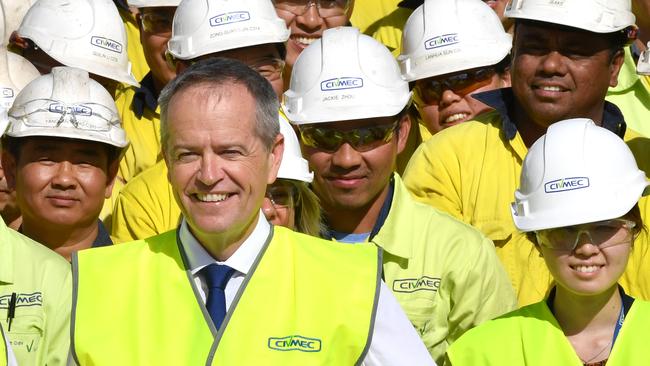Bill Shorten reheats Rudd school solar plan
Bill Shorten’s $1 billion cash splash to roll out solar and battery storage has triggered claims it will cost 4000 schools up to $380,000 each.

Bill Shorten’s $1 billion cash splash to roll out solar and battery storage across Australia — a move that builds on a signature Kevin Rudd policy — has triggered claims it will cost 4000 schools up to $380,000 each.
The Opposition Leader yesterday announced a plan to convert schools into “virtual power plants” with the new solar and battery systems aimed at pumping an extra 364 megawatts of electricity into the grid and shoring up reliability in the system.
Energy Minister Angus Taylor attacked the proposal, saying Labor was effectively promising a “billion dollars in debt for schools”.
He cited modelling by BAEconomics suggesting that Labor’s higher 45 per cent emissions target would also increase the cost of power by 58 per cent.
“Schools are in the business of educating students. Will school principals and education departments now be responsible for running power stations on their school grounds,” Mr Taylor said. “This is just another thought bubble from Bill Shorten. We know that Labor’s reckless emissions reduction targets will increase power prices.”
The government argues that under Labor’s plan to generate an extra 365MW of power, an average of 91 kilowatts of electricity power would be produced per school.
It also argues that a 91kW solar system would cost a school about $105,000 while the battery system to store the power would be up to $278,000.
Labor did not respond by deadline to specific questions from The Australian about the cost of installing new solar and battery storage systems. Mr Shorten yesterday said the scheme would be financed through concessional loans provided by the Clean Energy Finance Corporation, which — under its mandate — currently provides loans at between 4.4 per cent and 5.4 per cent.
“These are very sensible proposals, which are going to help schools with the cost-of-living challenges, which are going to help provide power into the grid and means that we can do something proper on climate change,” Mr Shorten said.
“We will work with both government and non-government schools to roll out this program.”
In July 2008, the then Rudd government opened its $480m National Solar Schools Plan aimed at rolling out solar panels in Australia’s 9500 schools by providing grants of up to $50,000. It was suspended in October 2009 because of higher-than-expected demand. The scheme was recalibrated as a competitive merit-based program, with schools required to demonstrate value for money, environmental and educational benefits in applications.
Labor deputy leader Tanya Plibersek yesterday said the party had “made sure that about half of Australian schools had solar panels when we were last in government” and described the new scheme as a “significant step up from that last program”.
“Even schools that have those earlier panels, like this school here, talk about the savings that they’re already making on their electricity bills,” she said.
“Now that panels are cheaper and more efficient, you’ll see even greater savings.”
Jeff Bye, founder and owner of Demand Manager in Sydney, a company that trades in small-scale technology certificates — a mechanism that incentives the installation of rooftop solar system — told The Australian the Labor plan was “positive”.
But he said the installation of more rooftop systems would also create more small-scale technology certificates, which energy retailers are required to buy, with the costs being ultimately passed on to consumers.
“If 4000 schools installed 100kW systems, then collectively that would equate to about 6.5 million small-scale technology certificates being generated, which — at the default price — would equate to about $250m of cost being added to Australia’s collective electricity bills,” Mr Bye said.
He said the Labor plan to use schools to generate an extra 360MW of power could prove to be a smart move because schools were already connected to the grid and it could remove the need to buy extra land or build substructures on which to install the panels.
A national audit of the renewable energy target last year showed that between 21 per cent and 27 per cent of small-scale rooftop solar installations inspected each year since 2011 had been found to have faulty wiring and unsecured panels, with some posing a “severe risk” where wiring was exposed.




To join the conversation, please log in. Don't have an account? Register
Join the conversation, you are commenting as Logout